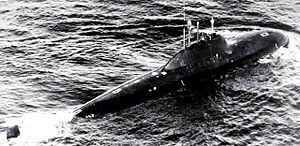Alfa-class submarine
 
Lira submarine (Project 705)
|
|
| Class overview | |
|---|---|
| Name: | Lira |
| Operators: | |
| In commission: | 1977 |
| Planned: | 8 |
| Completed: | 7 |
| Cancelled: | 1 |
| Retired: | 7 |
| General characteristics | |
| Type: | attack submarine |
| Displacement: | 2,300 tons surfaced, 3,200 tons submerged |
| Length: | 81.4 m (267 ft) |
| Beam: | 9.5 m (31 ft) |
| Draught: | 7.6 m (25 ft) |
| Propulsion: |
|
| Speed: | 12 kn (14 mph; 22 km/h) surfaced, 41 knots (47 mph; 76 km/h) submerged |
| Test depth: | 350 m test |
| Complement: | 31 (all officers) |
| Armament: |
|
The Soviet Union/Russian Navy Project 705 (Лира/Lira, "Lyre") was a class of hunter/killer nuclear-powered submarines. The class is also known by the NATO reporting name of Alfa. They were the fastest class of military submarines built, with only the prototype K-222 (NATO Papa class) exceeding them in submerged speed.
The Lira was a unique design among submarines. In addition to the revolutionary use of titanium for its hull, it used a powerful lead cooled fast reactor as a power source, which greatly reduced the size of the reactor compared to conventional designs, thus reducing the overall size of the submarine, and allowing for very high speeds. However, it also meant that the reactor had a short lifetime and had to be kept warm when it was not being used. As a result, the Liras were used as interceptors, mostly kept in port ready for a high-speed dash into the North Atlantic.
Project 705 was first proposed in 1957 by M. G. Rusanov and the initial design work led by Rusanov began in May 1960 in Leningrad with design task assigned to SKB-143, one of the two predecessors (the other being OKB-16) of the Malakhit Design Bureau, which would eventually become one of the three Soviet/Russian submarine design centers, along with Rubin Design Bureau and Lazurit Central Design Bureau. The project was highly innovative in order to meet demanding requirements: sufficient speed to successfully pursue any ship; the ability to avoid anti-submarine weapons and to ensure success in underwater combat; low detectability, in particular to airborne MAD arrays, and also especially to active sonars; minimal displacement; and minimal crew complement. A special titanium alloy hull would be used to create a small, low drag, 1,500 ton, six compartment vessel capable of very high speeds (in excess of 40 knots (46 mph; 74 km/h)) and deep diving. The submarine would operate as an interceptor, staying in harbor or on patrol route and then racing out to reach an approaching fleet. A high-power liquid-metal-cooled nuclear plant was devised, which was kept liquid in port through external heating. Extensive automation would also greatly reduce the needed crew numbers to just 16 men. The practical problems with the design quickly became apparent and in 1963 the design team was replaced and a less radical design was proposed, increasing all main dimensions and the vessel weight by 800 tons and almost doubling the crew.
...
Wikipedia
